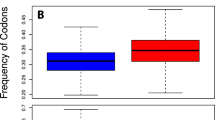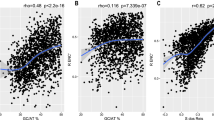Abstract
Unequal use of synonymous codons has been found in several prokaryotic and eukaryotic genomes. This bias has been associated with translational efficiency. The prevalence of this bias across lineages is currently unknown. Here, a new method (GCB) to measure codon usage bias is presented. It uses an iterative approach for the determination of codon scores and allows the computation of an index of codon bias suitable for interspecies comparison. A server to calculate GCB-values of individual genes as well as a list of compiled results are available at www.g21.bio.uni-goettingen.de . The method was applied to complete bacterial genomes. The relation of codon usage bias with amino acid composition and the choice of stop codons were determined and discussed.




Similar content being viewed by others
References
FM Adamski KK McCaughan F Jørgensen CG Kurland WP Tate (1994) ArticleTitleThe concentration of polypeptide chain release factors 1 and 2 at different growth rates of Escherichia coli. J Mol Biol 238 302–308 Occurrence Handle10.1006/jmbi.1994.1293 Occurrence Handle1:CAS:528:DyaK2cXktVCrt7Y%3D Occurrence Handle8176726
H Akashi (2001) ArticleTitleGene expression and molecular evolution. Curr Op Gen Dev 11 660–666 Occurrence Handle10.1016/S0959-437X(00)00250-1 Occurrence Handle1:CAS:528:DC%2BD3MXnslajtL0%3D
B Alberts D Bray J Lewis M Raff K Roberts JD Watson (1994) Molecular biology of the cell. Garland Publishing New York
SG Andersson CG Kurland (1990) ArticleTitleCodon preferences of free-living microorganisms. Microbiol Rev 54 198–210 Occurrence Handle1:CAS:528:DyaK3cXksFeiurk%3D Occurrence Handle2194095
JL Bennetzen BD Hall (1982) ArticleTitleCodon selection in yeast. J Biol Chem 257 3026–3031 Occurrence Handle1:CAS:528:DyaL38XitFWkt7w%3D Occurrence Handle7037777
A Coghlan KH Wolfe (2000) ArticleTitleRelationship of codon bias to mRNA concentration and protein length in Saccaromyces cerevisiae. Yeast 16 1131–1145 Occurrence Handle1:CAS:528:DC%2BD3cXmvFSitbY%3D Occurrence Handle10953085
JM Comeron M Aguadé (1998) ArticleTitleAn evaluation of measures of synonymous codon usage bias. J Mol Evol 47 268–274
JF Curran M Yarus (1989) ArticleTitleRates of aa-tRNA selection at 29 sense codons in vivo. J Mol Biol 209 65–77 Occurrence Handle1:CAS:528:DyaK3cXjvFOn Occurrence Handle2478714
JF Curran (1995) ArticleTitleDecoding with the A:I wobble pair is inefficient. Nucleic Acids Res 23 683–688 Occurrence Handle1:CAS:528:DyaK2MXksFKgtrg%3D Occurrence Handle7534909
DE Draper (1996) Translation initiation. FC Neidhardt (Eds) Escherichia coli and Salmonella, second edition. ASM Press Washington D.C. 902–908
H Engelberg-Kulka R Schoulaker-Schwarz (1996) Supression of termination codons. Escherichia coli and Salmonella. FC Neidhardt (Eds) Escherichia coli and Salmonella, second edition. ASM Press Washington D.C. 909–921
MA Freire-Picos MI González-Siso E Rodríguez-Belmonte AM Rodríguez-Torres E Ramil ME Cerdán (1994) ArticleTitleCodon usage in Kluyveromyces lactis and in yeast cytochrome c-encoding genes. Gene 139 43–49 Occurrence Handle10.1016/0378-1119(94)90521-5 Occurrence Handle1:CAS:528:DyaK2cXis1aks7c%3D Occurrence Handle8112587
DV Freistroffer M Kwiatkowski RH Buckingham M Ehrenberg (2000) ArticleTitleThe accuracy of codon recognition by polypeptide release factors. Proc Natl Acad Sci USA 97 2046–2051 Occurrence Handle1:CAS:528:DC%2BD3cXhslKhsLY%3D Occurrence Handle10681447
M Gouy C Gautier (1982) ArticleTitleCodon usage in bacteria: Correlation with gene expressivity. Nucleic Acids Res 10 7055–7074 Occurrence Handle1:CAS:528:DyaL3sXivVOquw%3D%3D Occurrence Handle6760125
R Grantham C Gautier M Gouy M Jacobzone R Mercier (1981) ArticleTitleCodon catalog usage is a genome strategy modulated for gene expressivity. Nucleic Acids Res 9 r43–r74 Occurrence Handle7208352
H Grosjean W Fiers (1982) ArticleTitlePreferential codon usage in prokaryotic genes: The optimal codon-anticodon interaction energy and the selective codon usage in efficiently expressed genes. Gene 18 199–209 Occurrence Handle10.1016/0378-1119(82)90157-3 Occurrence Handle1:CAS:528:DyaL38XmtV2ntr0%3D Occurrence Handle6751939
G Gutiérrez L Marquez A Marín (1996) ArticleTitlePreference for guanosine at first codon position in highly expressed Escherichia coli genes. A relationship with translational efficiency. Nucleic Acids Res 24 2525–2527 Occurrence Handle10.1093/nar/24.13.2525 Occurrence Handle8692691
FC Holstege EG Jennings JJ Wyrick TI Lee CJ Hengartner MR Green et al. (1998) ArticleTitleDissecting the regulatory circuitry of a eukaryotic genome. Cell 95 717–728 Occurrence Handle1:CAS:528:DyaK1cXnvFynurk%3D Occurrence Handle9845373
T Ikemura (1981) ArticleTitleCorrelation between the abundance of Escherichia coli transfer RNAs and the occurrence of the respective codons in its protein genes. J Mol Biol 146 1–21 Occurrence Handle1:CAS:528:DyaL3MXitVGhsbY%3D Occurrence Handle6167728
S Kanaya Y Yamada Y Kudo T Ikemura (1999) ArticleTitleStudies of codon usage and tRNA genes of 18 unicellular organisms and quantification of Bacillus subtilis tRNAs: Gene expression level and species-specific diversity of codon usage based on multivariate analysis. Gene 238 143–155 Occurrence Handle10.1016/S0378-1119(99)00225-5 Occurrence Handle1:CAS:528:DyaK1MXntFKnu74%3D Occurrence Handle10570992
S Karlin SF Altschul (1990) ArticleTitleMethods for assessing the statistical significance of molecular sequence features by using general scoring schemes. Proc Natl Acad Sci USA 87 2264–2268 Occurrence Handle1:CAS:528:DyaK3cXhslGhsbo%3D Occurrence Handle2315319
S Karlin J Mrázek AM Campbell (1998) ArticleTitleCodon usages in different gene classes of the Escherichia coli genome. Mol Microbiology 29 1341–1355 Occurrence Handle10.1046/j.1365-2958.1998.01008.x Occurrence Handle1:CAS:528:DyaK1cXmsVKisLc%3D
S Karlin J Mrázek (2000) ArticleTitlePredicted highly expressed genes of diverse prokaryotic genomes. J Bact 182 5238–5250 Occurrence Handle1:CAS:528:DC%2BD3cXmsVOqu7k%3D Occurrence Handle10960111
B Lafay JC Atherto PM Sharp (2000) ArticleTitleAbsence of translationally selected synonymous codon usage bias in Heliobacter pylori. Microbiology 146 851–860 Occurrence Handle1:CAS:528:DC%2BD3cXislOjs7c%3D Occurrence Handle10784043
HW Mewes D Frishman C Gruber B Geier D Haase A Kaps et al. (2000) ArticleTitleMIPS: A database for genomes and protein sequences. Nucleic Acids Res 28 37–40 Occurrence Handle10.1093/nar/28.1.37 Occurrence Handle1:CAS:528:DC%2BD3cXhvVGqu70%3D Occurrence Handle10592176
BR Morton (1994) ArticleTitleCodon usage and the rate of divergence of land plant chloroplast genes. Mol Biol Evol 11 231–238 Occurrence Handle1:CAS:528:DyaK2cXivFWis7c%3D Occurrence Handle8170364
I Moszer EPC Rocha A Danchin (1999) ArticleTitleCodon usage and lateral gene transfer in Bacillus subtilis. Curr Opin Micro 2 524–528 Occurrence Handle10.1016/S1369-5274(99)00011-9 Occurrence Handle1:CAS:528:DyaK1MXntlCku7o%3D
JA Novembre (2002) ArticleTitleAccounting for background nucleotide composition when measuring codon usage bias. Mol Biol Evol 19 1390–1394 Occurrence Handle1:CAS:528:DC%2BD38XmtF2rs7o%3D Occurrence Handle12140252
A Pan C Dutta J Das (1998) ArticleTitleCodon usage in highly expressed genes of Haemophilus influenzae and Mycobacterium tuberculosis: Translational selection versus mutational bias. Gene 215 405–413 Occurrence Handle1:CAS:528:DyaK1cXlvFSgsrg%3D
MY Pavlov DV Freistroffer V Dincbas J MacDougall RH Buckingham M Ehrenberg (1998) ArticleTitleA direct estimation of the context effect on the efficiency of termination. J Mol Biol 286 579–590 Occurrence Handle10.1006/jmbi.1998.2220
S Pedersen (1984) ArticleTitle Escherichia coli ribosomes translate in vivo with variable rate. EMBO J 3 2895–2898 Occurrence Handle1:CAS:528:DyaL2MXktVyisQ%3D%3D Occurrence Handle6396082
EP Rocha A Danchin A Viari (1999) ArticleTitleTranslation in Bacillus subtilis: Roles and trends of initiation and termination, insights from a genome analysis. Nucleic Acids Res 27 3567–3576 Occurrence Handle10.1093/nar/27.17.3567 Occurrence Handle1:CAS:528:DyaK1MXmtFCnurw%3D Occurrence Handle10446248
PM Sharp TMF Tuohy KR Mosurski (1986) ArticleTitleCodon usage in yeast: Cluster analysis clearly differentiates highly and lowly expressed genes. Nucleic Acids Res 14 5125–5143 Occurrence Handle1:CAS:528:DyaL28Xlt1yksbc%3D Occurrence Handle3526280
PM Sharp WH Li (1987) ArticleTitleThe codon adaptation index—A measure of directional synonymous codon usage bias, and its potential applications. Nucleic Acids Res 15 1281–1295 Occurrence Handle1:CAS:528:DyaL2sXhtlejtrc%3D Occurrence Handle3547335
MA Sørensen CG Kurland S Pedersen (1989) ArticleTitleCodon usage determines translation rate in Escherichia coli. J Mol Biol 207 365–377 Occurrence Handle2474074
C Spearman (1904) ArticleTitleThe proof and measurement of association between two things. Am J Psych 15 72–101
AO Urrutia LD Hurst (2001) ArticleTitleCodon usage bias covaries with expression breadth and the rate of synonymous evolution in humans, but this is not evidence for selection. Genetics 159 1191–1199 Occurrence Handle1:CAS:528:DC%2BD38XjvVamtA%3D%3D Occurrence Handle11729162
F Wright (1990) ArticleTitleThe “effective number of codons” used in a gene. Gene 87 23–29
Acknowledgements
This work was supported by a grant of the Bundesministerium für Bildung und Forschung. I would like to thank W. Kramer and the referees for their assistance in preparing the manuscript.
Author information
Authors and Affiliations
Corresponding author
Appendix: Genomic Data Sets (Accession numbers in brackets)
Appendix: Genomic Data Sets (Accession numbers in brackets)
Archaea
Archaeoglobus fulgidus (NC000917), Halobacterium sp. NRC-1 (NC002607), Methanobacterium thermoautotrophicum (NC000916), Methanococcus jannaschii (NC000909), Methanosarcina mazei (AE008384), Pyrococcus abyssi (NC000868), Pyrococcus horikoshii (NC000961), Sulfolobus solfataricus (NC002754), Sulfolobus tokodaii (NC003106), Thermoplasma acidophilum (NC002578), Thermoplasma volcanium (NC002689).
Bacteria
Aquifex aeolicus (NC000918), Bacillus halodurans (NC002570), Bacillus subtilis (NC000964), Brucella melitensis (Chromosome 2, AE008917), Borrelia burgdorferi (NC001318), Buchnera sp. APS (NC002528), Campylobacter jejuni (NC002163), Chlamydia muridarum (NC002620), Chlamydia trachomatis (NC000117), Chlamydophila pneumoniae J138 (NC002491), Chlamydophila pneumoniae AR39 (NC002179), Deinococcus radiodurans (Chromosome 1, NC001263), Escherichia coli K-12 (NC000913), Escherichia coli O157:H7 EDL933 (NC002655), Haemophilus influenzae Rd (NC000907), Helicobacter pylori 26695 (NC000915), Helicobacter pylori J99 (NC000921), Lactococcus lactis subsp. lactis (NC002662), Mesorhizobium loti (NC002678), Mycobacterium tuberculosis (NC000962), Mycoplasma genitalium (NC000908), Mycobacterium leprae strain TN (NC002677), Mycoplasma pneumoniae (NC000912), Mycoplasma pulmonis (NC002771), Mycobacterium tuberculosis CDC1551 (CD 002755), Neisseria meningitidis Z2491 (NC003116), Pseudomonas aeruginosa (NC002516), Rickettsia prowazekii (NC000963), Staphylococcus aureus subsp. aureus N315 (NC002745), Staphylococcus aureus strain Mu50 (NC002758), Streptococcus pneumoniae R6 (NC003098), Streptococcus pneumoniae TIGR4 (NC003038), Streptococcus pyogenes (NC002737), Synechocystis sp. PCC6803 (NC000911), Thermotoga maritima (NC000853), Treponema pallidum (NC000919), Ureaplasma urealyticum (NC002162), Vibrio cholerae (NC002505, NC002506), Yersinia pestis (NC003143). The following data sets contained no annotation and could not be analyzed: All data sets of Agrobacterium tumefaciens, Pasteurella multocida (NC002663), Xylella fastidiosa (NC002488).
Eukaryota
Saccharomyces cerevisiae (a data set prepared by MIPS, which contains 6449 entries, Mewes et al. 2000).
mRNA Concentration Data
Data of Holstege et al. (1998) were obtained from http://www.wi.mit.edu/young/expression.html .
Rights and permissions
About this article
Cite this article
Merkl, R. A Survey of Codon and Amino Acid Frequency Bias in Microbial Genomes Focusing on Translational Efficiency . J Mol Evol 57, 453–466 (2003). https://doi.org/10.1007/s00239-003-2499-1
Received:
Accepted:
Issue Date:
DOI: https://doi.org/10.1007/s00239-003-2499-1




